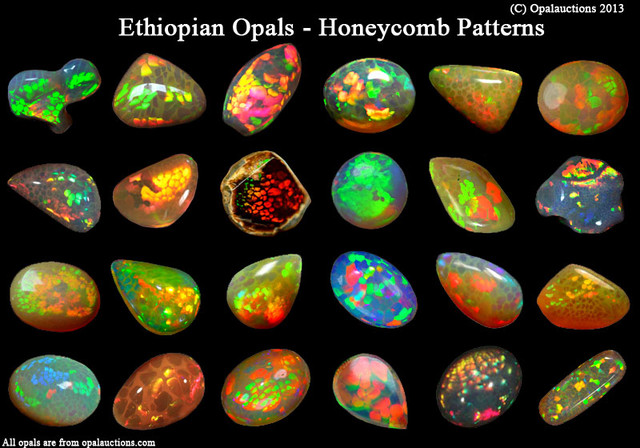
发布时间4th Apr 2017
修改于17th Nov 2025
水蛋白石信息
水溶蛋白石(Hydrophane Opal)是一个新术语,用来描述一种特定类型的蛋白石。欧洲开采蛋白石已有数千年历史,澳大利亚的开采历史也超过165年。然而,埃塞俄比亚蛋白石和水溶蛋白石的发现仅有约20年的历史。近十年来,这种材料的商业产量显著增加。
著名人类学家路易斯·利基在肯尼亚的一个洞穴中发现了已知最早的蛋白石遗迹。这些蛋白石很可能来自公元前4000年的埃塞俄比亚。有趣的是,已知最古老的蛋白石可能就产自埃塞俄比亚,而如今埃塞俄比亚已被视为一个新的蛋白石产区。
水合物韦洛蛋白石简介
我从2008年开始少量购买韦洛原石,现在购买量已达数公斤。2008年,我切割了几千颗韦洛宝石,并不断摸索适合自己的切割工艺。2009年,我售出了第一颗韦洛宝石。如今,我已经售出了数百颗经过处理的韦洛宝石,并收藏了一批不同类型和纹理的切割韦洛宝石,供大家研究。所有韦洛宝石都具有水溶性。
韦洛蛋白石有两种类型,正如您所读到的,大部分是“吸水蛋白石”,它们能吸收大量水分,也能蒸发大量水分。另一种是“非吸水蛋白石”,其特性与澳大利亚蛋白石非常相似,切割方式也相同。吸水蛋白石在接触大量水后会褪色并改变透明度。我用Genie机器在水流冲洗下切割所有韦洛蛋白石,完全浸泡几个小时后,大多数白色底的吸水蛋白石会变得晶莹剔透,有时甚至会褪去全部或大部分颜色。不过不用担心,即使经过几个小时的水浸泡,经历了切割和抛光这一“人生中最艰难的考验”,几乎所有的蛋白石最终都能“焕然一新”,恢复到之前的状态,所有颜色都会重新显现,有些甚至会“闪闪发光”!
我购买韦洛原石时,通常选择5克及以上的,10克到40克的比较常见。这比大多数人切割用的矿场原石要好得多!我使用较大的原石是因为切割时我不进行热熔处理,只是直接用手拿着切割。这样做的一个好处是,韦洛宝石对热的适应性较差,如果暴露在过高温度下容易开裂,所以如果需要热熔处理,我会选择冷熔法。这只是我的个人偏好,但可以提高我的成品率,因为韦洛宝石的成品率通常很低,大多数情况下,去除基质和一些天然裂纹后,大约有三分之二的宝石会被损失。虽然可以通过挑选每一颗宝石来提高成品率,但这在美国很难做到。
根据我的经验,使用 Welo 原石时,如果使用金刚石磨料,必须至少用 3000 目金刚石磨料打磨,才能密封表面,使其均匀膨胀和收缩。如果只打磨一部分,然后放置一两个小时使其干燥,那么下次再处理时,原石很可能已经开裂。此外,如果原石中残留任何基质,其反应也会与母石不同,可能导致裂纹。我使用 14K 目金刚石磨料进行抛光,最后用氧化铈进行最终抛光,以获得镜面般的光泽。这种高度抛光的表面有助于减少佩戴时宝石水分的流失或吸收,并降低宝石表面吸收异物的可能性,同时还能减少宝石对不同气候的敏感性。正是这种密封作用,使得您的 Welo 宝石即使沾水也不会出现明显的底色或光泽损失。
我还切割了一些黑色晶体底的韦洛蛋白石,发现几乎全部都不具有吸水性。所有吸水性蛋白石的吸水性强弱各不相同。有的切开后几乎感觉不到吸水性,有的吸水性极强,只要手指上沾了一点水就会粘在上面,就像小孩把舌头贴在冻住的游乐设施上,舌头立刻就被冻住了一样!
韦洛蛋糕的黄色中心,或者说“蛋黄”,有些切割器会自动去除它们,但我没有发现裂纹和蛋黄之间的关联,所以如果它们在艺术上不吸引人,我就会去除它们。但有些蛋糕有变色效果,有时也挺吸引人的。顺便说一句,有些蛋糕根本不是黄色的,它们可以完全变成透明的无色。
我发现,通过这种抛光系统完全密封表面后,就不需要使用其他密封剂了,但是必须对所有侧面进行处理才能密封。
欧泊拍卖文献中有很多“几何”图案,例如蜂窝状、鱼鳞状、彩虹棱镜状、丝带状等等,这些图案由于普遍使用,已成为公认的描述。这些图案在其他大多数产地的欧泊中非常罕见,但在埃塞俄比亚欧泊中却很常见,有些被认为是优质图案,拍卖价格可能高于其他图案。
有些宝石的一面切割成一种图案,而另一面则完全是另一种图案。这些图案通常是由构成宝石的细胞结构决定的,从不同角度观察这些细胞会改变其形成的图案。
大多数宝石匠可能不同意我的方法,但对我来说很有效,而且不会影响原石的稳定性。当你准备将原石切割成宝石时,我会先将原石浸入水中一次,然后观察原石表面的反应。如果原石有任何裂缝,水会渗入裂缝中,几秒钟后,裂缝壁吸水的地方会出现较深的线条,而裂缝处则会变成一条细细的透明线。如果你在切割时仔细观察,就能发现任何裂缝,并大致判断裂缝的深度。有些裂缝只在表面,可以通过打磨或抛光去除,就像龟裂一样。有时,龟裂还能增强成品宝石的变彩效果。如果成品宝石经过切割和抛光后,大约一天左右的时间,它就会形成该有的龟裂或细纹,所以当你在拍卖会上看到它时,它已经完成了彻底抛光后应有的形态。我研究过的Welo Fine Gems宝石中,没有一颗出现裂纹,也没有一颗因为裂纹而被退回。请放心,只要保养得当,它们只需在略微干燥时用肥皂和水清洗即可。无需将它们浸泡在水、甘油或油等液体中,也不要将它们放在阳光直射的地方,例如透过窗户或其他热源照射的地方。如果你的手能承受高温,那么你的Welo Hydrophane Opal也一定能承受!
既然提到了裂纹,它并非总是坏事。我有一颗330克拉的韦洛水晶,火彩和色彩都非常漂亮,但表面布满了裂纹,这些裂纹折射光线,增强了变彩效果。我把这颗巨大的韦洛水晶设计成蘑菇的形状,方法是在上面加了一个韦洛底座,这样既增加了深度和造型感,看起来也确实像一朵蘑菇。我打磨了一些窗口,露出了宝石内部无裂纹的部分,同时也发现了韦洛水晶的另一种独特现象——“幻影”!这种现象看起来像是蛋白石中又有一颗蛋白石,有些幻影会呈现变彩效果,有时与母体蛋白石的颜色不同,而有些则只是浅灰色。关于这种“幻影”的成因和性质,目前众说纷纭,莫衷一是。
这让我想到了韦洛组地层,我们知道韦洛组地层和墨西哥组地层以及许多其他组地层一样,都是火山成因的,但我也发现了一些含有植物物质(如根和稻草)的韦洛组地层,还有一些是明显的“枝干铸型”,这为长期渗流置换的可能性提供了佐证,树枝和根部以化石的形式出现在蛋白石内部。
对于 Welo 产区的 Hydrophane 蛋白石而言,买家渴望拥有这些美丽的色彩和纹理,而这些也确实存在,即使是较小的原石,也能找到它们的身影。您会看到一些商品描述中会用“5/5”或“3.5/5”来表示光泽度,其中 1 代表最暗淡的颜色,5 代表最闪亮的颜色。如果您正在寻找具有这些特性的蛋白石,Welo 产区的蛋白石拥有一些最闪亮的晶莹蛋白石,以及丰富多样的纹理和变彩。
当我们最初开始研究韦洛蛋白石时,我们意识到在将其推向市场之前,需要一段静置或干燥的时间,大多数人都同意尝试静置一年(12个月)。但在我研究过这些宝石之后,我认为整整一年并非必要,所以我通常会将我的水溶蛋白石静置几个月,或者在某些情况下更短,具体取决于每颗宝石所展现的水溶特性程度。
现在来说说“非氢化”Welo,就简单说一两句话!它占我使用过的所有Welo的10%到20%,它的切割和性能几乎在所有方面都和澳大利亚产的Welo一样。
以上是我在研究了数年、数千颗具有欺骗性的 Welo Hydrophane 宝石之后的一些想法和发现!
开采深度是否决定了埃塞俄比亚蛋白石的稳定性?
目前还没有针对特定地区开采的蛋白石的形成方式以及这是否会影响蛋白石稳定性进行过研究。
在闪电岭的蛋白石矿区,矿工们都知道,如果深入某些矿区,蛋白石的稳定性就会降低。
大多数矿工在 20-30 米的深度作业,蛋白石比较稳定;但如果你在某些地区挖得更深,矿石会变得比较软,蛋白石的稳定性就会降低。
有些蛋白石矿区,例如梅赫夫(Mehive),以出产大量不稳定的蛋白石而闻名,人们会用晶体来制作双层或三层蛋白石。
这种陶土质地也更柔软,外观更像湿陶土,而不是干陶土。
但是埃塞俄比亚的蛋白石是火山成因的,矿工们会水平开采,而不是像大多数蛋白石矿那样垂直开采。
由于这种埃塞俄比亚蛋白石形成于地震频发的剧烈火山地区,而该国也以地震和火山活动频繁而闻名。
因此,当发现新的蛋白石矿床时,我们无法得知它是如何形成的,也无法得知它形成于多深的地下。
这可能是某些地区比其他地区更容易出现裂纹的原因,如果你关注埃塞俄比亚卖家在蛋白石拍卖会上的反馈,你会发现很多回头客都在购买,所以这个蛋白石产地的蛋白石市场更加稳定。
这虽然不科学,但可以解释为什么有些埃塞俄比亚原石能产出更稳定的蛋白石。
航空旅行会对水溶性埃塞俄比亚蛋白石产生影响吗?
最近在一次蛋白石展上,我遇到一位蛋白石批发商,他从澳大利亚带了一些韦洛蛋白石到美国。他把一些埃塞俄比亚蛋白石放在随身行李里,一些放在托运行李里。
当他抵达美国时,他注意到托运行李中的蛋白石表面有一些裂纹,但他随身携带的蛋白石却完好无损。

所以看来大气压力或湿度的变化对水蛋白石产生了影响?
通过检查大气压力,我们发现大多数喷气式飞机的行李舱都设有压力控制装置,但大多数行李舱没有加热,温度仅略高于冰点。即使是较老旧的飞机,其压力也可能不如航空公司公布的那样准确。
我认为目前还没有人研究过大气压力或湿度变化对韦洛蛋白石的影响。既然钻石是在自然压力下形成的,那么水蛋白石也可能受到大气压力的影响。
对于航空旅客来说,飞机在12,500英尺(3,800米)的高度就需要增压。我们都熟悉飞机快速下降或高原反应时耳膜受到的压力。许多人都有过饮料瓶在行李箱里爆炸或洗发水瓶在托运行李里爆炸的经历。显然,如果洗发水瓶不是满的,就不会爆炸。
这让我们不禁思考水凝蛋白石中的水,因为水在压力下无处可去,而且如果蛋白石在飞机迅速下降到干燥湿度环境中时结冰,这可能会对蛋白石产生影响?
动物运输通常使用加温加压的行李舱,但航空公司使用不同的行李舱。大多数行李舱没有加热设施,有时行李到达时会非常冷。那么,这块蛋白石在干燥潮湿的环境中会怎么样呢?
断裂测试
宝石切割师对石英进行断裂测试已有数百年历史。早在16世纪的德国,他们就通过施加压力,将石英置于热水、冷水或冰块中进行断裂测试。这样,石英就会在其最薄弱处开裂,切割师便可放心地对岩石进行雕刻和塑形,而不必担心出现更多裂纹。
或许航空旅行也会对某些水溶蛋白石造成同样的影响?影响水溶蛋白石的因素有很多。受影响的蛋白石比例可能很小,但值得研究。大多数国际航班的飞行高度为39,000英尺(12,000米)。
你能做什么?
你不能把装有韦洛蛋白石的塑料袋装水,因为它们会吸收水分,改变外观。而且,即使不考虑机舱压力或温度问题,水本身也可能因为吸收不均匀而导致蛋白石开裂。大多数原石都非常干燥,而且最终都会空运到国外,所以除非切割后的蛋白石仍然含有水分,否则机舱压力应该不会造成太大影响。冷冻也只会影响到含有水分且结冰后体积膨胀的蛋白石,因此彻底干燥韦洛蛋白石是必须的。
最终,我们还是无法找到埃塞俄比亚韦洛蛋白石受航空旅行影响的确切原因。
购买埃塞俄比亚蛋白石
搜索Opal Encyclopedia
最新的文章
文章分类
All there is to know about Opals including Black Opals, Ethiopian Opals & Boulder Opal
14文章数
Check out our fascinating information and articles on all things amazing in the Opal world
41文章数





